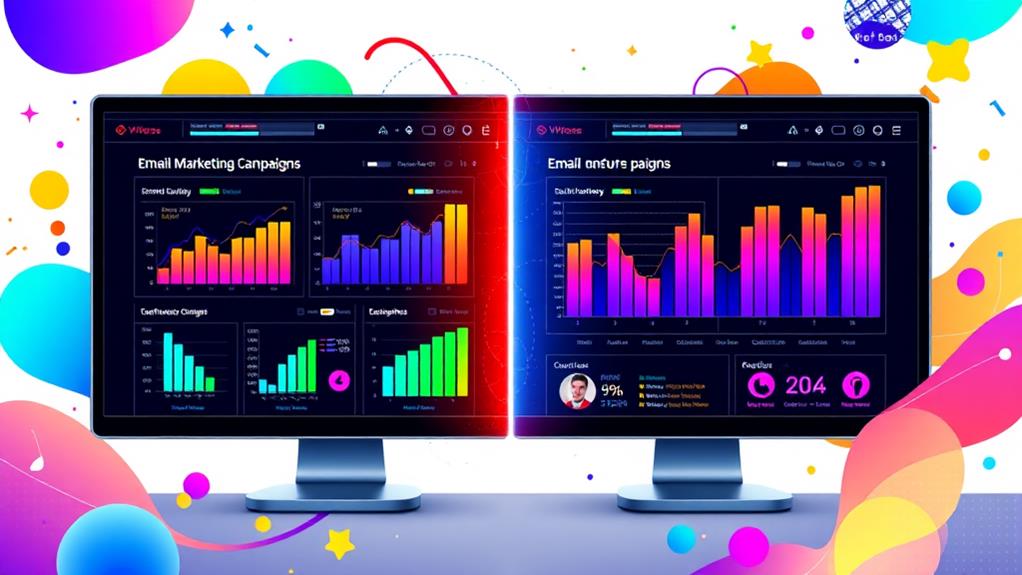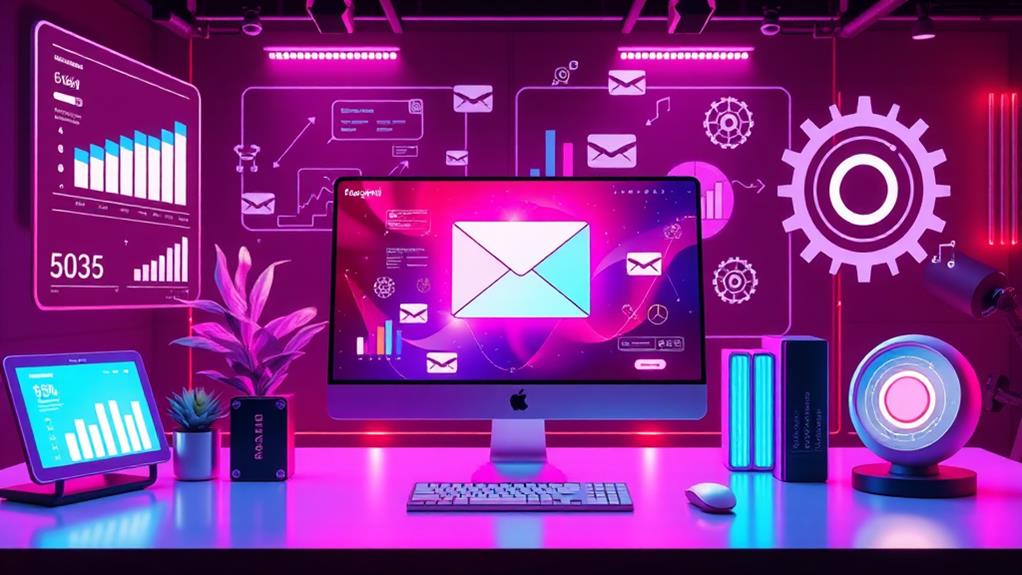Email segmentation is a powerful tool that markedly enhances targeted marketing campaigns, proven by data showing a 14.31% increase in open rates and a staggering 100.95% rise in clicks. By strategically segmenting based on demographics, behaviors, and psychographics, businesses can achieve a 30% boost in conversions and greatly improve engagement rates, even recovering up to 10% of inactive subscribers. Behavioral and lifecycle segmentation optimizes messaging relevance, aligning with subscriber interests and journey stages. These tactics not only bolster ROI but also fuel marketing success. Discover deeper insights into leveraging segmentation for transformative campaign outcomes.
Key Takeaways
- Utilize behavioral targeting to enhance engagement rates, focusing on subscriber actions and preferences.
- Implement psychographic segmentation to align messages with subscribers' interests and values for increased conversion rates.
- Leverage lifecycle stage segmentation to tailor emails based on customer journey stages, boosting retention and re-engagement.
- Use geographic segmentation to deliver location-specific content, increasing open rates.
- Identify inactive subscribers for personalized outreach, potentially recovering engagement and improving conversion rates.
Understanding Email Segmentation
Email segmentation serves as the blueprint for crafting personalized and effective marketing campaigns by dividing a broader audience into smaller, more targeted groups based on specific criteria such as demographics, behaviors, and purchase history.
This strategic approach acknowledges the diverse needs and preferences of subscribers, ultimately enhancing the customer experience and engagement rates. Research highlights that segmented email campaigns boast a 14.31% increase in open rates and an impressive 100.95% surge in clicks compared to their non-segmented counterparts, underscoring the efficacy of segmentation.
A critical component of email segmentation is demographic analysis, which enables marketers to tailor messages that resonate with specific age groups, genders, or locations.
By utilizing engagement metrics, businesses can further refine their strategies, focusing on how subscribers interact with previous emails to boost relevance and reduce unsubscribe rates. This data-driven method not only amplifies the impact of communications but also optimizes resource allocation by targeting the right audience with the right message.
Incorporating these insights into segmentation strategies not only enhances targeting precision but also greatly increases the return on investment (ROI), making it an indispensable tool in the arsenal of modern email marketing.
Advanced Segmentation Techniques
Building on the foundational principles of email segmentation, advanced techniques offer marketers even greater precision and opportunities for engagement.
Behavioral targeting is a standout method, enhancing engagement rates by up to 100% by focusing on subscribers' actions and preferences. This approach transcends basic demographics, enabling a deeper connection with each recipient.
Similarly, psychographic segmentation empowers marketers to craft messages aligned with subscribers' interests and values, achieving a 30% increase in conversion rates over generic campaigns.
To further optimize email strategies, consider these advanced segmentation techniques:
- Lifecycle Stage Segmentation: Tailor emails based on a customer's journey stage—new, active, or lapsed—to boost retention and re-engagement.
- Geographic Segmentation: Deliver location-specific content, achieving a 14% higher open rate by aligning promotions with local events or weather.
- Inactive Subscriber Segmentation: Identify disengaged users and implement win-back strategies, potentially recovering up to 10% of inactive customers through personalized outreach.
These techniques underscore the strategic advantage of advanced segmentation.
Maximizing Engagement With Segmentation
Harnessing the potential of segmentation is crucial for maximizing engagement in email marketing campaigns. Segmented campaigns yield a 14.31% higher open rate than their non-segmented counterparts, underscoring the importance of aligning email content with audience preferences. By refining messaging based on recipient demographics and behaviors, marketers can deliver content relevance that resonates, markedly reducing unsubscribe rates.
Personalization, particularly through purchase history, further enhances engagement by providing tailored product recommendations. This approach not only fosters deeper connections but also boosts click-through rates by up to 20%. Mailchimp's findings that segmented emails achieve 100.95% more clicks than non-segmented ones highlight the power of targeted messaging in driving user interaction and engagement.
Moreover, addressing audience preferences through re-engagement campaigns for inactive subscribers is a strategic move. Tailored content can revive interest and lead to higher conversion rates, emphasizing the critical role of segmentation in maintaining subscriber activity.
Leveraging Data for Precision
A robust foundation of first-party data is essential for executing precision-driven email segmentation strategies. By leveraging data driven insights, marketers can craft highly personalized campaigns that greatly enhance subscriber engagement.
According to Mailchimp, segmented email campaigns achieve 14.31% higher open rates and 100.95% more clicks compared to their non-segmented counterparts, underscoring the power of targeted messaging.
To maximize the potential of segmentation, marketers should consider the following strategic approaches:
- Utilize Demographic Data: Tailor content to specific age groups, locations, or other demographic segments to guarantee relevance and engagement.
- Incorporate Behavioral Triggers: Use insights from subscriber interactions and purchase history to send timely, contextually relevant messages.
- Enrich Data Points: Continuously update and expand databases with information such as engagement levels and transaction history for deeper segmentation.
Real-Life Segmentation Success Stories
Success in email marketing often hinges on strategic segmentation, as demonstrated by numerous real-life examples. A clothing retailer harnessed the demographic impact by pinpointing millennials with tailored fashion recommendations, achieving a notable 30% increase in sales during the campaign. This underscores the power of demographic segmentation in driving purchase decisions.
Similarly, an online bookstore capitalized on behavioral insights by examining purchase history. By sending curated book suggestions based on previous buying patterns, they realized a substantial 45% surge in repeat purchases, illustrating the efficacy of behavior-driven strategies.
Further highlighting the potency of segmentation, a fitness app leveraged behavioral insights to enhance user engagement. They sent workout reminders to active users while enticing inactive users with exclusive offers, leading to a 50% uplift in retention rates. This dual approach exemplifies how understanding user behavior can effectively re-engage diverse user segments.
Additionally, a travel company utilized geographic segmentation to promote region-specific deals, achieving a remarkable 60% higher open rate compared to generic promotions, emphasizing location-based targeting efficiency.
Frequently Asked Questions
How Can Small Businesses Implement Segmentation Without Extensive Resources?
Small businesses can leverage segmentation by analyzing customer behavior, utilizing demographic targeting, and monitoring engagement metrics. This data-driven approach enables the creation of personalized content, fostering strategic connections with audiences without requiring extensive resources.
What Tools Are Available for Automating Email Segmentation?
To automate email segmentation effectively, consider using tools like Mailchimp, HubSpot, or ActiveCampaign. These segmentation tools offer automation benefits by enhancing precision, efficiency, and personalization, thereby driving better customer engagement and optimizing marketing strategies.
How Often Should Segmentation Criteria Be Updated?
Segmentation criteria should be evaluated quarterly, aligning with dynamic market trends and consumer behavior shifts. Adhering to these frequency guidelines guarantees strategic optimization, enhancing campaign effectiveness through timely, data-driven adjustments and refined audience targeting methodologies.
What Are Common Mistakes to Avoid When Segmenting Email Lists?
Common mistakes in email list segmentation include neglecting demographic insights, overlooking behavioral triggers, misinterpreting engagement metrics, and ignoring content preferences. Strategically utilizing these data points guarantees precise targeting and enhances campaign efficacy, achieving ideal audience engagement and conversion rates.
Can Segmentation Improve Email Deliverability Rates?
Segmentation can enhance email deliverability rates by implementing personalization strategies that align with recipient preferences. This approach boosts engagement metrics, as targeted content reduces bounce rates and increases open rates, ultimately optimizing email campaign effectiveness and deliverability.
Conclusion
Email segmentation, when executed with advanced techniques and data-driven strategies, greatly enhances campaign targeting and engagement. By leveraging extensive data analysis, marketers can achieve precision in audience segmentation, leading to more relevant and effective communication. The strategic implementation of segmentation techniques not only maximizes engagement but also drives measurable success, as evidenced by real-life case studies. Ultimately, employing sophisticated segmentation methods is pivotal in optimizing email marketing efforts and achieving superior campaign outcomes.




